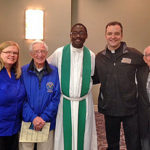
Timothy Walch reviews “A Garden Catechism” by Margaret Rose Realy, Obl OSB.
By Tim Walch
Book Review
“A Garden Catechism: 100 Plants in Christian Tradition and How to Grow Them.” By Margaret Rose Realy, Obl OSB, Illustrated by Mary Sprague. Our Sunday Visitor, 2022, 333 pp. $34.95.

“The earth shall be filled with knowledge of the Lord.” This passage from Isaiah (11:9) begins a beautiful book that will be valued by anyone who sees the wonder of God’s work and the wisdom of Christianity in flowers, trees and other plants.
Author Margaret Rose Realy, a Benedictine Oblate and an advanced master gardener, has a gift for combining Christian traditions with practical advice on growing a wide variety of plants. She has channeled her skills into this book and a wide variety of other publications.
“A Garden Catechism” focuses on creating faith-based gardens that are more than landscaping. As noted in the subtitle, Realy focuses on a hundred plants, most of them flowers. Not to be overlooked is the practical advice on how to grow and maintain these plants.
Some readers may be curious about the title. “A catechism,” Realy notes in her preface, “is a way of teaching the Faith that strengthens the bonds of unity in our Church and, according to the Catechism of the Catholic Church, enlivens the faith of the People of God.” Realy reaches this goal by showing us all how plants reflect our faith.
The book is divided into chapters on flowers, herbs and edibles, grasses, trees and shrubs. Practical sections on gardening basics, supplemental Catholicism and an introduction to prayer gardens are among the offerings. The book concludes with reference charts, a bibliography and an index.
Each of the four chapters on plants are arranged alphabetically. The first entry in the chapter on flowers, for example, begins with “Anemone” and ends with “Yarrow.” For each plant, Realy offers a section on the Christian references to each plant and a second section on the growing culture for that plant. Just as important, each entry features a beautiful illustration by Mary Sprague.
Realy was almost born to preach the gospel in the garden. “Flowers had been a part of my childhood,” she writes in her introduction. “Plants and nature defined who I was and brought me great happiness.”
As her love and understanding of nature matured, she also grew in her faith. “I soon realized that there was a need to instruct the faithful in how to connect the Creator through his creation and historiated Christian symbolism.” Her work has guided the faithful in determining what garden elements would lead them into contemplation and prayer.
Realy stresses the natural synergy between faith and nature. “Spiritually dedicated gardens,” she writes, “are those that attend to the interior need of our heart, mind and soul, offering a place where both people and plants can grow.” Plants can be portals to drawing us closer to the Creator through his creations.
So how does a novice begin a spiritual garden? Realy offers a simplified way that emphasizes discernment, design, and development. For discernment, the new gardener needs to assess the environment and location of the new garden. Realy advises a space with privacy and shade.
On design, Realy uses a “three-by-three rule.” She advises that spiritual gardens find harmony when the plants come in three heights, three textures, and three colors. She also cautions gardeners to remember that the plants will transition through four seasons.
Finally, on development, Realy advises gardeners to begin with a conceptual map for the location of the plants and the icons to be featured. Begin where you enter the garden, decide where you will place statues or shrines, and then draw in the plants you have selected to fill out the garden.
The result will be satisfying beyond expectation — even if you are struggling with your own faith. In fact, in the words of Sherry Weddell, “the spiritual impact of nature — including the natural beauty in a garden — can be another bridge to faith in Jesus Christ for the unchurched and unbelievers.” And wouldn’t that be a wonderful thing for all of us.
(Timothy Walch is a lay director at St. Thomas Mare Parish in Coralville and a member of The Catholic Messenger’s board of directors. He reviews books for the “Messenger” and other publications and is the author or editor of many books including “Irish Iowa” (2019).)











